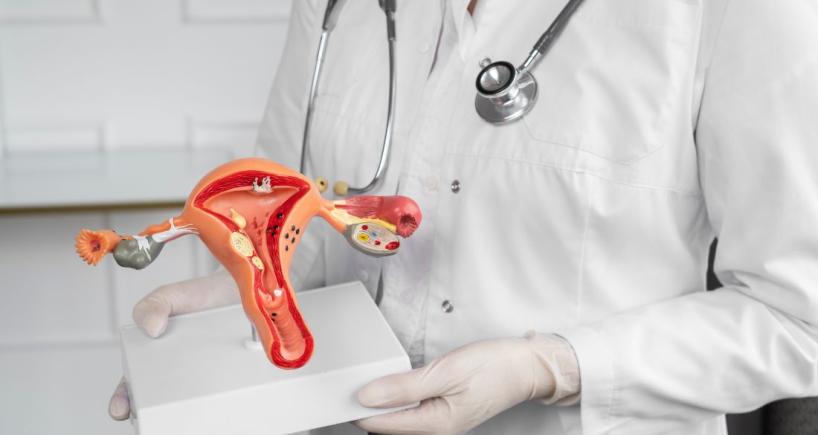
Hysteroscopy for Infertility: Procedure, Risks, and Recovery
Globally, millions of couples suffer from infertility, which is the inability to conceive after one year trying to conceive for many years. Advancements in medical science have provided various solutions with different diagnoses and treatment options for this problem. Of such option, one such tool called hysteroscopy has become increasingly important in the journey towards parenthood.
Hysteroscopy is surgery with minimally invasive techniques providing the doctors a chance to assess and treat the lining of the uterus that could be causing infertility. In this blog, we will take time and discuss more on hysteroscopy as a procedure, it’s risks and the recovery process of individuals who try this procedure to get rid of the problem.
Understanding Hysteroscopy and its types
The hysteroscopy involves a minimal invasive procedure where a doctor inserts a thin, telescopic
During hysteroscopy, the doctor inserts a thin, telescope-like instrument known as a hysteroscope into the uterus through the cervix. This instrument enables the doctor to visualize the interior of the uterus and the characteristics of the endometrium, the position of the openings of both fallopian tubes, and other abnormalities. There are two types of hysteroscopy:
Diagnostic hysteroscopy: This is a visual inspection in the uterine cavity to identify the cause of infertility. It helps to find the occurrence of disease conditions like fibroids, polyps, adhesions, or abnormities in the uterine cavity that might prevent implantation. This is the common form of hysteroscopy that can be performed for a short duration in an outpatient setting.
Operative hysteroscopy: This type of hysteroscopy is carried out for treatment purposes, considering the confirmed abnormalities. It involves using surgical instruments through the hysteroscope to remove polyps, fibroids, or adhesions, thus improving the chances of successful pregnancy.
Procedure:
A hysteroscopy is typically done outpatient or day-case, allowing the patient to return home on the same day without a hospital admission or overnight hospital stay.
Anesthesia Considerations
In many cases, anesthesia is not necessary. If needed, local anesthetic may be administered to numb the cervix. General anesthesia might be used if therapeutic interventions are required during the procedure or if the patient prefers to be unconscious.
Procedure Steps
The patient lies on an examination table on their back with their hips elevated and knees stretched to 10-15 degree with lower extremities raising. A sheet or gown may be given to wear during the procedure. The doctor examines the pelvis and dilates the cervix to perform the hysteroscope procedure.
Insertion of Hysteroscope: The hysteroscope, a thin, lighted tube, is gently passed through the dilated cervix into the uterine cavity.
A sterile fluid is pumped into the uterus to expand the cavity, providing a clear view of the uterine walls and lining.
Visualization: The hysteroscope's camera transmits images to a monitor, allowing the physician to inspect the uterine cavity for abnormalities.
In case of any surgery, suitable instruments are introduced through the hysteroscope to perform therapeutic procedures.
Duration and Pain Management
Procedure Length: The duration of a hysteroscopy can vary. Diagnostic hysteroscopies typically take 5 to 10 minutes, while therapeutic procedures may last up to 30 minutes.
Patients may experience discomfort or pain during the procedure. It is advisable to take analgesics such as paracetamol or ibuprofen 1 to 2 hours before the appointment.
If the procedure becomes too painful, it is important to inform the healthcare provider, as the hysteroscopy can be stopped at any time.
This comprehensive approach ensures that patients undergoing hysteroscopy receive appropriate care and pain management while facilitating accurate diagnosis and treatment of uterine abnormalities.
Risk
Both diagnostic and surgical outpatient hysteroscopy are effective, safe, and well-tolerated. However, outpatient hysteroscopy can cause a great deal of pain, anxiety, and embrace, much like any surgery involving uterine equipment. These factors can affect women’s satisfaction with the procedure and may also impact its feasibility, safety, accuracy, and effectiveness. To minimize pain and discomfort, different types of hysteroscopic equipment, technique modifications, and medications have been suggested.
Recovery
Most people recover quickly after undergoing the hysteroscopy. One can expect to feel some cramping and have light bleeding for a couple of days. You should refrain from sexual activity or go to the gym based on recommendations by your doctor. Most women can go back to their usual activities within a few days.
Hysteroscopy is an important procedure used both in investigations and the treatment for infertility issues. It is minimally invasive, with a short recovery time, and holds good promise of a remarkable improvement in fertility for reliable couples who are desirous of having a family. Being aware of the procedure, its advantages, and potential risks helps one make an informed decision regarding reproductive health and, therefore, to proceed with the fertility journey in full confidence.
Popular Searches :
Hospitals: Cancer Hospital in Delhi | Best Heart Hospital in Delhi | Hospital in Amritsar | Hospital in Ludhiana | Hospitals in Mohali | Hospital in Faridabad | Hospitals in Gurgaon | Best Hospital in Jaipur | Hospitals in Greater Noida | Hospitals in Noida | Best Kidney Hospital in Kolkata | Best Hospital in Kolkata | Hospitals in Rajajinagar Bangalore | Hospitals in Richmond Road Bangalore | Hospitals in Nagarbhavi Bangalore | Hospital in Kalyan West | Hospitals in Mulund | Best Hospital in India | | Cardiology Hospital in India | Best Cancer Hospital in India | Best Cardiology Hospital in India | Best Oncology Hospital In India | Best Cancer Hospital in Delhi | Best Liver Transplant Hospital in India
Doctors: Dr. Rana Patir | Dr. Rajesh Benny | Dr. Rahul Bhargava | Dr. Jayant Arora | Dr. Anoop Misra | Dr. Manu Tiwari | Dr. Praveer Agarwal | Dr. Arup Ratan Dutta | Dr. Meenakshi Ahuja | Dr. Anoop Jhurani | Dr. Shivaji Basu | Dr. Subhash Jangid | Dr. Atul Mathur | Dr. Gurinder Bedi | Dr. Monika Wadhawan | Dr. Debasis Datta | Dr. Shrinivas Narayan | Dr. Praveen Gupta | Dr. Nitin Jha | Dr. Raghu Nagaraj | Dr. Ashok Seth | Dr. Sandeep Vaishya | Dr. Atul Mishra | Dr. Z S Meharwal | Dr. Ajay Bhalla | Dr. Atul Kumar Mittal | Dr. Arvind Kumar Khurana | Dr. Narayan Hulse | Dr. Samir Parikh | Dr. Amit Javed | Dr. Narayan Banerjee | Dr. Bimlesh Dhar Pandey | Dr. Arghya Chattopadhyay | Dr. G.R. Vijay Kumar | Dr Ashok Gupta | Dr. Gourdas Choudhuri | Dr. Sushrut Singh | Dr. N.C. Krishnamani | Dr. Atampreet Singh | Dr. Vivek Jawali | Dr. Sanjeev Gulati | Dr. Amite Pankaj Aggarwal | Dr. Ajay Kaul | Dr. Sunita Varma | Dr. Manoj Kumar Goel | Dr. R Muralidharan | Dr. Sushmita Roychowdhury | Dr. T.S. MAHANT | Dr. UDIPTA RAY | Dr. Aparna Jaswal | Dr. Ravul Jindal | Dr. Savyasachi Saxena | Dr. Ajay Kumar Kriplani | Dr. Nitesh Rohatgi | Dr. Anupam Jindal |
Specialties: Heart Lung Transplant | Orthopedic | Cardiology Interventional | Obstetrics & Gynaecology | Onco Radiation | Neurosurgery | Interventional Cardiology | Gastroenterologist in Jaipur | Neuro Physician | Gynecologist in Kolkata | Best Neurologist in India | Liver Transfer











